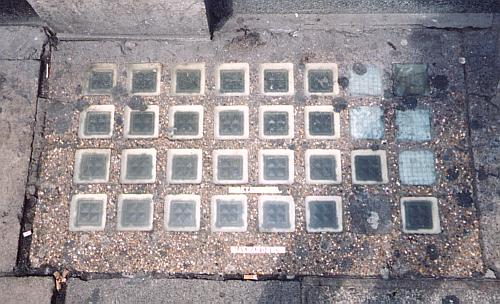Glass block flooring
Glass block flooring is used in many different situations, from bridge walkways and mezzanine floors to balconies, corridors and public highways. They are most commonly used as pavement lights - glass lenses set into precast concrete as part of pavement construction to allow natural light into the space below.
They were developed in the 1880s as cast iron frames glazed with cut squares of glass, intended to provide a natural light source for basements and cellars beneath the pavement. Gradually these were superseded by reinforced concrete panels with plain glass fenestration, but these were then superseded themselves by pressed glass prism lenses, designed to transmit the maximum amount of light.
They can be constructed in situ, although in the UK they are predominantly precast in factory-controlled conditions to individual project specifications.
There are currently no British or European standards that apply to pavement lights or other precast concrete panels with glass block or paver inserts. Manufacturers must test their pavement light products to determine loading, thermal, acoustic and fire performance, as well as compliance with any local authority or building regulations requirements.
Design considerations include:
- Type and percentage of light transmittance required.
- Type of likely traffic (i.e. pedestrian, vehicular, etc.).
- Loading requirements of the panel.
- Fire integrity and thermal isolation rating of the panel.
- Thermal performance.
- Slip resistance.
- Expansion joints.
Glass lenses are typically 20-22 mm thick, have a flat, smooth finish, and are available in 100 x 100 mm and 200 x 200 mm squares.
Pavement lights for heavy duty applications (such as loading bays, roadways, and so on), must be capable of sustaining significant loads. The required loading determines the spanning ability, but spans of up to 4.4 m can be achieved with distributed loadings of up to 20 kN/m2.
Slip resistance is measured on the overall surface of the panel, not just the glass or concrete. Improved slip resistance can be provided by sandblasted pavers which add chromite or carborundum grains in the concrete wearing surface.
Glass paver lenses can also be used for vertical precast reinforced concrete panels. These are sometimes used for windows and rooflights in spaces such as prisons and detention rooms.
Another variation is the precast concrete stair tread, which incorporate glass pavers or blocks, sometimes in combination with glazed floor panels.
[edit] Related articles on Designing Buildings Wiki
- Coal holes, pavement lights, kerbs and utilities and wood-block paving.
- Floor definition.
- Glass block wall.
- Glass bottle floor foundation.
- Glass for buildings.
- Glazing.
- Kerbs.
- Pavegen.
- Pavement.
- Security glazing.
- Solar Squared.
- Types of flooring.
- Types of road and street.
[edit] External resources
- The NBS - Pavement lights
Featured articles and news
One of the most impressive Victorian architects. Book review.
RTPI leader to become new CIOB Chief Executive Officer
Dr Victoria Hills MRTPI, FICE to take over after Caroline Gumble’s departure.
Social and affordable housing, a long term plan for delivery
The “Delivering a Decade of Renewal for Social and Affordable Housing” strategy sets out future path.
A change to adoptive architecture
Effects of global weather warming on architectural detailing, material choice and human interaction.
The proposed publicly owned and backed subsidiary of Homes England, to facilitate new homes.
How big is the problem and what can we do to mitigate the effects?
Overheating guidance and tools for building designers
A number of cool guides to help with the heat.
The UK's Modern Industrial Strategy: A 10 year plan
Previous consultation criticism, current key elements and general support with some persisting reservations.
Building Safety Regulator reforms
New roles, new staff and a new fast track service pave the way for a single construction regulator.
Architectural Technologist CPDs and Communications
CIAT CPD… and how you can do it!
Cooling centres and cool spaces
Managing extreme heat in cities by directing the public to places for heat stress relief and water sources.
Winter gardens: A brief history and warm variations
Extending the season with glass in different forms and terms.
Restoring Great Yarmouth's Winter Gardens
Transforming one of the least sustainable constructions imaginable.
Construction Skills Mission Board launch sector drive
Newly formed government and industry collaboration set strategy for recruiting an additional 100,000 construction workers a year.
New Architects Code comes into effect in September 2025
ARB Architects Code of Conduct and Practice available with ongoing consultation regarding guidance.
Welsh Skills Body (Medr) launches ambitious plan
The new skills body brings together funding and regulation of tertiary education and research for the devolved nation.
Paul Gandy FCIOB announced as next CIOB President
Former Tilbury Douglas CEO takes helm.
























Comments
walkways, mezzanine floors, balconies, corridors and public highways outside buildings, allowing natural daylight to flood below.
Glass floor blocks and lenses used in horizontal applications are specially manufactured and differ from glass blocks used in vertical walling.